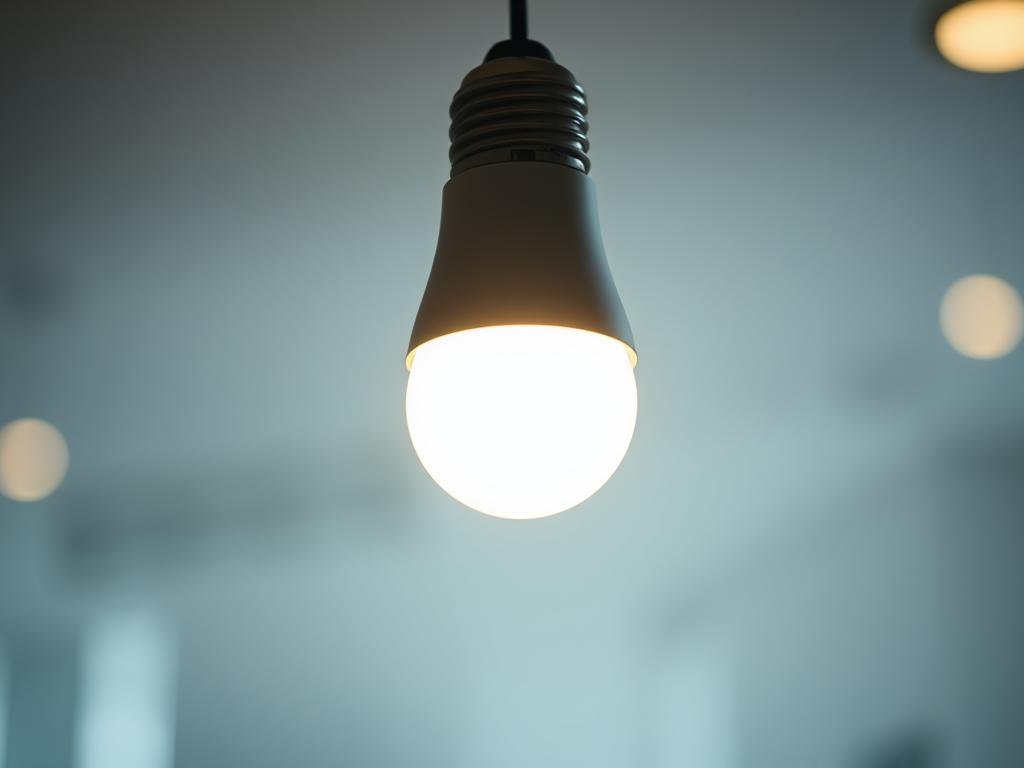Did you know 63% of people bought a smart home device to keep an eye on their home from afar? This shows how big of a deal smart home technology, like smart light bulbs, is in our lives.
When you add these cool devices to your home, you might run into problems. Like when your smart light bulbs just won’t work. It’s really annoying, right? To fix it, first check the simple stuff. Make sure the outlet or switch is okay and the bulb isn’t broken.
If it’s a bigger problem, you might need to look into your smart home setup. Check the connections and make sure all devices work together. If you’re really stuck, there are troubleshooting guides out there to help.
Understanding Smart Light Bulb Basics
Smart light bulbs are changing how we light our homes. They mix technology with saving energy. Knowing the basics is key.
What Are Smart Light Bulbs?
Smart light bulbs are LED bulbs you can control wirelessly. You can use a smartphone app, voice commands, or a smart home hub. They bring together energy saving and smart features.
How Do Smart Light Bulbs Work?
These bulbs connect to your Wi-Fi network. This lets you control them from anywhere. You can set them to turn on or off, change brightness, and even color.
Setting up smart light bulbs is easy. You just need a compatible hub or bridge. Then, you can manage them through an app. This lets you schedule and access your bulbs remotely.
Benefits of Using Smart Light Bulbs
Smart LED bulbs save energy. They let you control when and how you use lights. This cuts down on energy waste. Plus, they last longer than regular bulbs, so you don’t need to replace them as often.
They also make life easier. You can control your lights from anywhere. And, you can set up special lighting scenes for different times. Some bulbs even let you change the color to match your mood.
| Feature | Benefit |
|---|---|
| Remote Control | Convenience and flexibility in managing your lighting |
| Energy Efficiency | Reduced energy consumption and lower utility bills |
| Customization | Ability to create personalized lighting scenes for different occasions |
A leading expert in smart home tech says, “Smart lighting is more than saving energy. It’s about making your home more comfortable, convenient, and connected.” This shows how smart light bulbs can improve your home life.
Common Causes for Smart Light Bulb Issues
Knowing why smart light bulbs malfunction is key to fixing them. It’s frustrating when they don’t work right. But, finding out what’s wrong is the first step to solving the problem.
Connectivity Problems
One big reason smart light bulbs might not work is connectivity issues. This could be a weak WiFi signal, too much network traffic, or router problems. Make sure your WiFi is strong and your bulbs are close to the router. For more on smart home tech issues, check out Atomismart’s blog.
Power Supply Failures
Power supply failures are another common problem. This can happen if the power source is bad, the bulb is installed wrong, or the bulb itself has issues. Check the power supply and make sure the bulb is installed right to fix these problems.
Compatibility Issues
Compatibility problems can also cause issues. This happens when your smart light bulbs don’t work with your smart home system. Make sure your devices are compatible before buying. For more on smart home compatibility, visit Digital Vista Online.
Understanding these common causes helps you prevent or fix smart light bulb problems. Regular maintenance and checks keep your automated lighting working well.
Troubleshooting Steps to Take First
If your smart light bulb isn’t working, start with basic troubleshooting. Voice-controlled light bulbs, a key part of smart lighting, can be tricky. But, there are a few steps to get them working again.
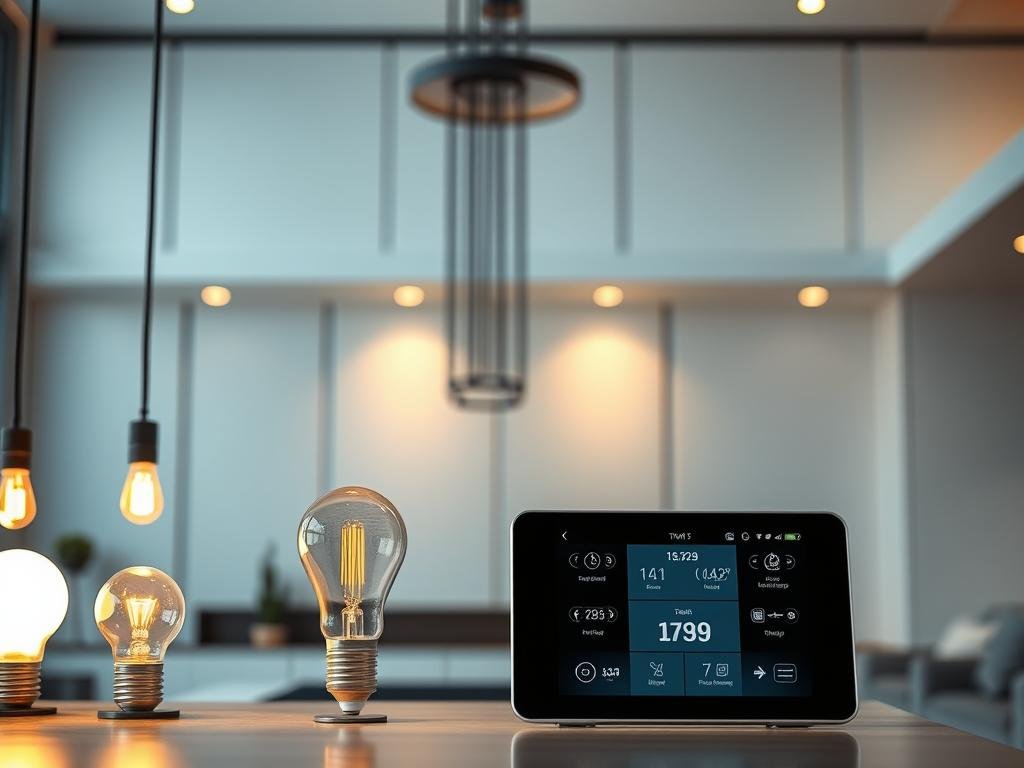
Restarting Your Smart Light Bulb
One easy fix is to restart your smart light bulb. Turn it off using your app or voice assistant, wait a bit, then turn it back on. This is like rebooting your computer and often fixes connectivity problems.
Checking Your Wi-Fi Connection
A strong Wi-Fi connection is key for smart light bulbs. Make sure your Wi-Fi is working and your bulb is connected. Check your Wi-Fi status through your router or a network scanning app. For more on setting up your smart lighting, visit TechRadar’s guide on the best smart.
Ensuring Proper Installation
Proper installation is essential for your smart light bulb. Make sure it’s screwed in right and there are no power issues. As “Smart lighting is not just about illumination; it’s about creating an ecosystem that makes your life easier.” – a statement that shows how important a well-installed system is.
By trying these initial steps, you can often fix issues with your smart light bulbs. This way, you can enjoy the convenience of your voice-controlled lighting system.
Resetting Your Smart Light Bulb
If your smart light bulb isn’t working, try resetting it. Resetting can fix many problems, like connection issues or software bugs.
Why Resetting Matters
Resetting your smart light bulb is key. It brings the device back to its original settings. This helps if you’ve changed your Wi-Fi or updated your smart home system.
Benefits of Resetting:
- Resolves connectivity issues
- Clears software glitches
- Restores device to factory settings
How to Reset Different Brands
Resetting varies by brand. Here are steps for some popular ones:
- Philips Hue: Turn the bulb on and off 5 times to reset it.
- LIFX: Use the LIFX app to reset the bulb.
- Belkin Wemo: Press and hold the reset button for 10 seconds.
Always check your bulb’s manual or the manufacturer’s website for the right steps. Procedures can differ.
Verifying Successful Reset
After resetting, make sure it worked. Here’s how:
- Check if the bulb responds to its app or voice commands.
- Ensure the bulb is connected to your Wi-Fi network.
- Test the bulb’s functionality, like dimming or color changing.
If the bulb doesn’t work after resetting, you might need more troubleshooting or customer support.
Some of the best smart bulbs include Philips Hue, LIFX, and Belkin Wemo. They’re known for being reliable and easy to use.
Updating Software and Firmware
Your energy-efficient lighting works best with the latest software and firmware updates. Keeping your smart LED bulbs updated does more than fix problems. It also boosts their performance and keeps them energy-efficient.
Keeping Software Current
Updating your smart light bulbs’ software is key for their best performance. Updates often fix bugs, improve how they work, and add new features. For example, an update might make your bulbs respond faster or work better with other smart devices.
Why is this important? Old software can cause problems like connectivity issues and reduced performance. It might even make your bulbs stop working. By updating, you keep your bulbs working with the latest tech and efficiently.
Checking for Updates
To find updates, use the app for your smart light bulbs. Most apps let you control your bulbs, adjust settings, and check for updates. Here’s how to do it:
- Open the app for your smart light bulbs.
- Go to the settings or device management section.
- Look for “Check for Updates” or something like it.
- If there’s an update, follow the prompts to download and install it.
For specific steps, check your user manual or the manufacturer’s website. Some users have faced issues with updates, as seen in this forum thread. It’s key to follow the manufacturer’s instructions.
Updating Your Smart Light Bulb
When you find an update, updating your bulb is easy. The app will show you how, which usually involves downloading and applying the update. Make sure your bulb is on and connected to Wi-Fi during this.
Tips for a smooth update: Make sure your bulb is well-powered and your Wi-Fi is stable. Don’t interrupt the update, as it can mess with your bulb’s function.
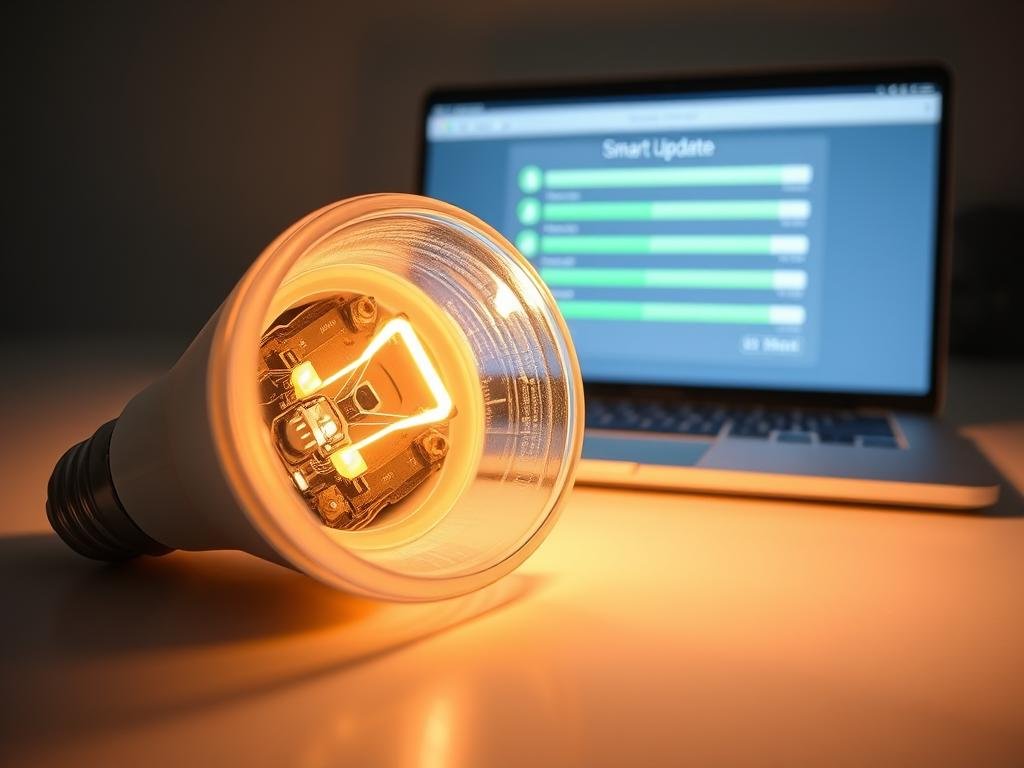
By keeping your smart LED bulbs’ software and firmware updated, you ensure they work well and stay energy-efficient. Regular updates can greatly improve your smart lighting experience.
Interference Factors in Smart Light Systems
Smart light bulbs can face interference in your smart home. Knowing and fixing these issues is key for a smooth smart home experience.
Sources of Interference
Many things can cause trouble for smart light systems. Devices like cordless phones, microwaves, and nearby Wi-Fi can mess with your bulbs’ connection to the hub or app.
Start by checking your smart light’s frequency. They usually use 2.4 GHz or 5 GHz. If other devices use the same or nearby frequencies, they can cause problems.
| Device | Frequency Band | Potential for Interference |
|---|---|---|
| Cordless Phones | 2.4 GHz | High |
| Microwaves | 2.4 GHz | High |
| Neighboring Wi-Fi Networks | 2.4 GHz / 5 GHz | High |
| Bluetooth Devices | 2.4 GHz | Moderate |
Minimizing Interference Effects
To cut down on interference, you can take a few steps. Try to use fewer devices on the same frequency in your home. If you can, switch some to a different frequency.
Also, make sure your smart light bulbs and hub are placed well. Avoid physical barriers and keep them close to each other for a better connection.
“By understanding the sources of interference and taking proactive steps to minimize their impact, you can significantly enhance the performance and reliability of your smart light system.”
Keeping your smart light system’s software and firmware updated is also important. Updates often improve how devices talk to each other and make them more reliable.
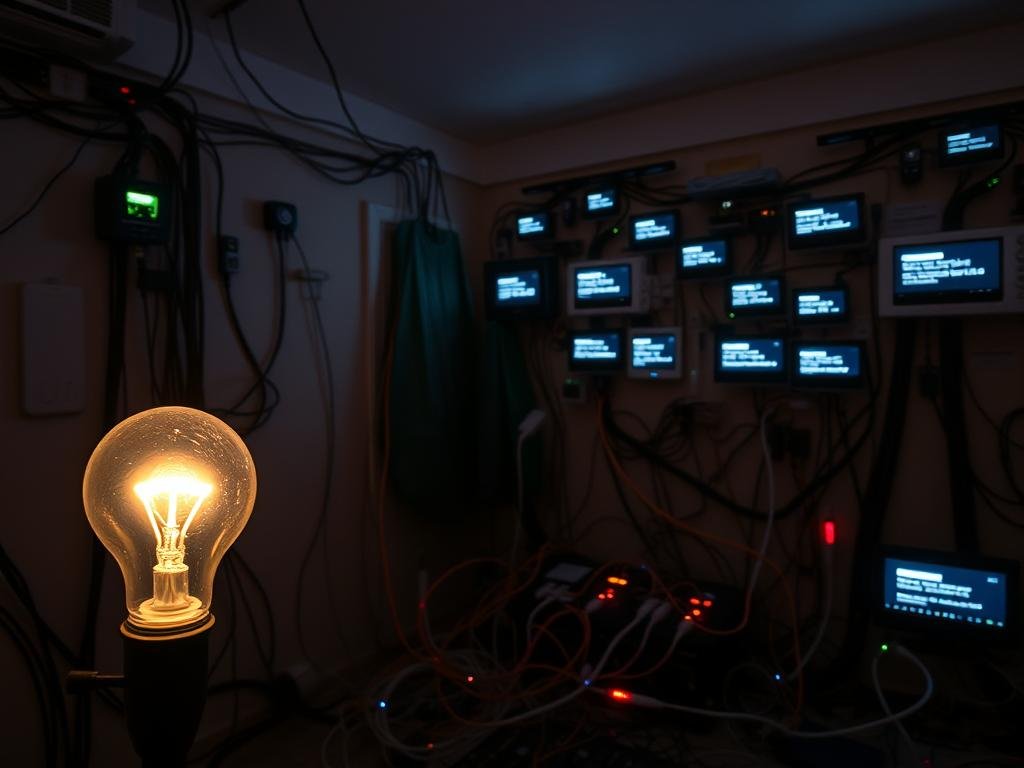
By knowing about interference and fixing it, you can make your smart lighting system work better. This will make your smart home more efficient and responsive.
Exploring Alternative Control Methods
You can control your WiFi light bulbs in many ways, not just through the app. The flexibility of WiFi lets you manage your lighting system in different ways. This makes it easy to adjust your lighting to fit your needs.
Using Manual Switches
One easy way to control your smart light bulbs is with manual switches. Even though they’re designed for remote control, you can use the old-fashioned way. This is handy during power outages or when you need to cut off power to the bulb.
Tip: Make sure your smart light bulbs work with the switch you have. This avoids any problems.
Utilizing Remote Controls
Some smart light bulb systems come with remote controls. These let you change the lighting without touching the bulb or phone. It’s great for adjusting lights from another room or when you’re busy.
For example, some brands offer remotes that control many bulbs at once. This makes managing your lighting easier.
Voice Command Options
Voice-controlled light bulbs are getting more popular. They let you control your lights with voice commands through smart speakers like Amazon Alexa or Google Assistant. This hands-free option is super convenient, whether your hands are full or you’re in another room.
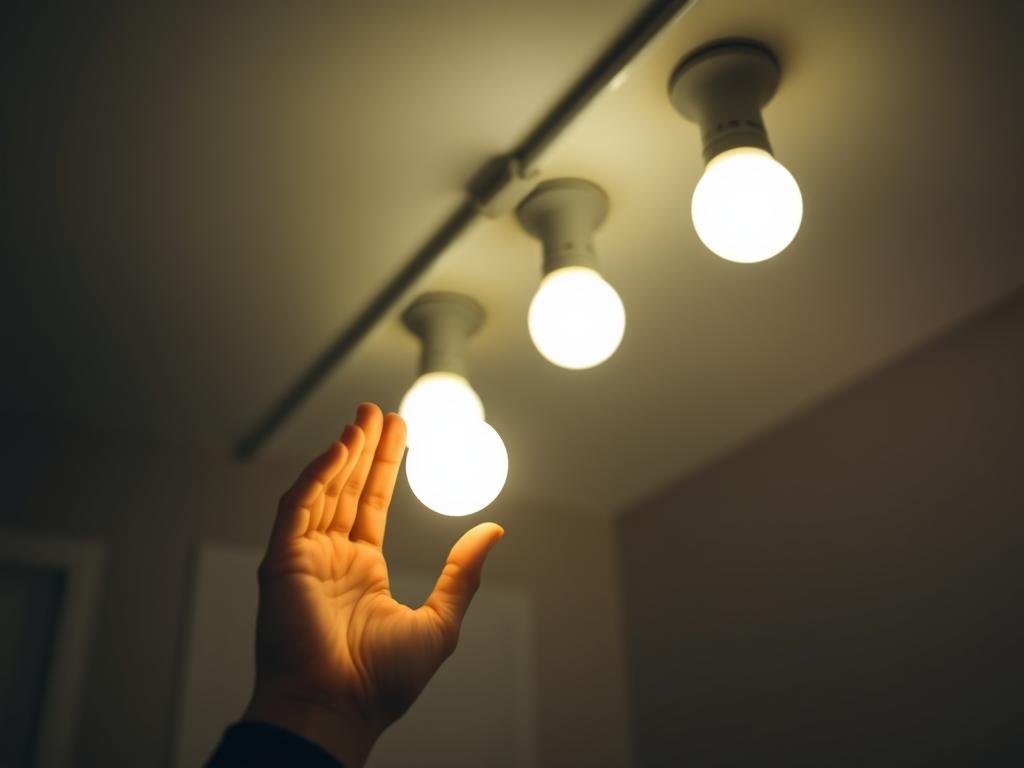
To use voice commands, check if your smart light bulbs work with your smart speaker. Then, you can control your lights with simple voice commands. For example, say “turn on the living room lights.”
When to Seek Professional Assistance
If your smart bulbs keep malfunctioning, it’s time to call for help. Issues with your smart lighting systems might mean a bigger problem. This could need a professional’s touch.
Signs of Electrical Problems
Look out for these signs to know when to get help:
- Flickering lights that don’t stop after replacing the bulb
- A burning smell coming from the light fixture or bulb
- Sparks when turning on the light
- Frequent overheating of the bulb or fixture
These signs could mean serious electrical issues. It’s important to keep your home’s electrical system safe. A pro can find and fix these problems.
Contacting Customer Support
Before you call a technician, reach out to the customer support of your smart bulb’s maker. They can help solve many problems. They can also tell you if your product is covered by warranty.
Some of the best smart bulbs have great customer support. They can guide you through troubleshooting or offer a replacement if needed.
Choosing a Qualified Technician
For professional installation or repair, pick a qualified technician carefully. Look for someone certified and experienced with smart lighting systems. Ask friends for recommendations or check online reviews.
Make sure the technician knows your brand of smart bulbs. They should also have the right tools to solve your problem quickly.
Maintaining Your Smart Light Bulbs for Longevity
To keep your smart light bulbs working well, regular care is key. Simple steps can make them last longer and improve your smart home setup.
Cleaning Your Smart Light Bulbs
Dusting your smart light bulbs often helps avoid grime that can mess with their performance. Use a soft, dry cloth to wipe away dust or dirt.
Best Usage Practices
Switching your smart light bulbs on and off too much can shorten their life. Also, use them in temperatures they’re meant for.
Avoiding Common Mistakes
Make sure to use your smart light bulbs in the right fixtures. Wrong wattage or voltage can cause them to fail early.
By following these easy care tips, you can make your smart lighting system more efficient and last longer. This will boost your smart home experience.
FAQ
What are smart light bulbs and how do they work?
Smart light bulbs are energy-saving lights you can control from your phone or voice. They connect to your Wi-Fi. This lets you change their brightness, color, and schedule.
Why is my smart light bulb not responding?
Issues might include connection problems or power failures. Try restarting the bulb and checking your Wi-Fi. Make sure it’s installed right.
How do I reset my smart light bulb?
Resetting varies by brand. You might need to turn it on and off a few times. Or use the app. Check your manual or the manufacturer’s website for details.
Why is it important to update my smart light bulb’s software and firmware?
Updates bring new features and security fixes. They keep your bulb working well with your smart home. It also saves energy.
What can interfere with my smart light system?
Devices, walls, and nearby Wi-Fi can cause problems. Move your router, use a range extender, or change Wi-Fi channels to reduce interference.
Can I control my smart light bulb manually?
Yes, you can use switches, remote controls, or voice commands. Some bulbs also have physical controls.
When should I seek professional assistance for my smart light bulb issues?
If you see flickering, overheating, or smells, get help. Or if you’re stuck troubleshooting or resetting. Contact support or an electrician.
How can I maintain my smart light bulbs for longevity?
Clean them often, avoid extreme temperatures, and update regularly. Use them wisely to last longer.
Are there any best practices for using smart light bulbs with voice control?
Make sure your bulb works with your voice assistant. Use clear commands. Try scenes and scheduling for a better experience.
Can I use smart light bulbs with different smart home systems?
Many bulbs work with systems like Alexa, Google, or Apple HomeKit. Check compatibility before buying.
